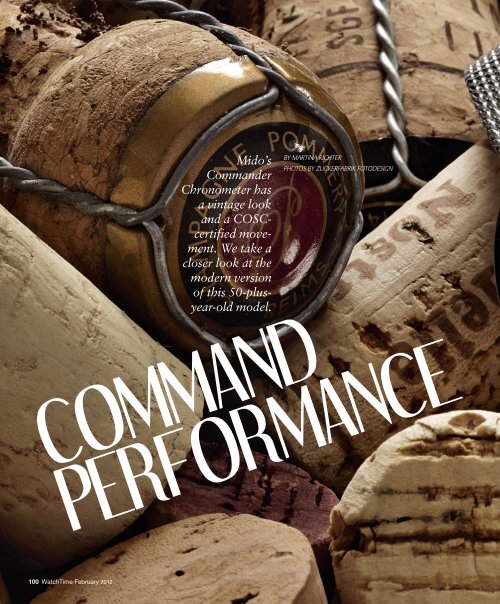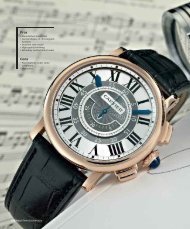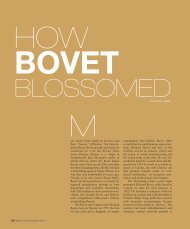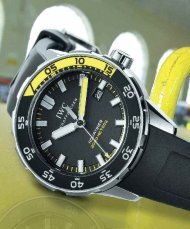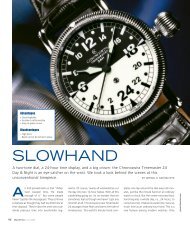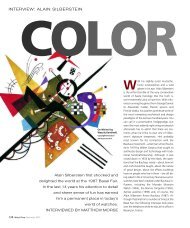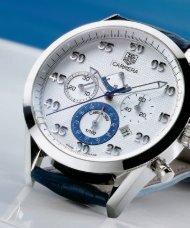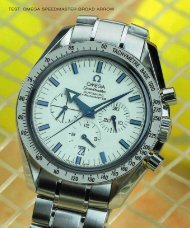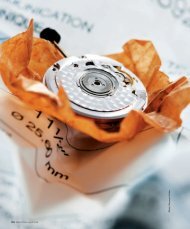WT_2012_01: CLOSE-UP: MIDO COMMANDER CHRONOMETER
WT_2012_01: CLOSE-UP: MIDO COMMANDER CHRONOMETER
WT_2012_01: CLOSE-UP: MIDO COMMANDER CHRONOMETER
- No tags were found...
You also want an ePaper? Increase the reach of your titles
YUMPU automatically turns print PDFs into web optimized ePapers that Google loves.
The Commander’s movementis the automatic ETACaliber 2836-2.The modern-dayCommander looksmuch like its precursorof 50 years ago.the other end will overlap it so that it’sout of sight. Once fitted properly, thebracelet hugs the wrist comfortably: nopinching or pressing.The bracelet is joined to the case by aspecial component that makes thebracelet especially secure. The disadvantageof this is that it’s not very easy to removethe bracelet and replace it with another.Mido also offers the CommanderChronometer with a gold case and instrap versions.Viewed from the side, the case looks alittle like a UFO. Its back is slightly convex;a Hesalite crystal covers the dial.When Mido introduced this type ofmonocoque case on the Ocean Star in1959, it was regarded as revolutionarybecause it eliminated the problem ofmaking the caseback water-resistant. Asits name suggests, a monocoque case ismade from a single piece of metal withouta removable back cover. (Coque isFrench for “shell.”)The absence of a removable backmeans that the movement must be insertedfrom above, and if a watchmaker everneeds to refurbish or repair it, he mustfirst remove the crystal, the hands and thedial. The winding stem is divided intotwo parts so the movement can be liftedout of the case, and returned to it, fromabove. The outer part of the windingstem can be removed along with thecrown.The crown itself is very small — only4.5 millimeters — and fits into an indentationon the flank of the case. When thecrown is pushed in all the way, it essentiallydisappears into this indentation.This protects the crown and enhances thewatch’s appearance, but it makes thecrown harder to use. You need strong fingernailsto pull the crown out into its otherpositions — for quickly adjusting thedate and day displays and setting thehands — and the job is somewhat clumsy.Winding the watch is also a challenge:you can’t get hold of the crown, so youcan only attempt to roll a fingertip alongits rim. The watch is an automatic; it paysto wear it as often as possible so you willseldom need to wind it manually.SPECS<strong>MIDO</strong> <strong>COMMANDER</strong> <strong>CHRONOMETER</strong>Manufacturer: Mido AG, Chemin desTourelles 17, 2400 Le Locle, SwitzerlandReference number: M84294C111Functions: Hours, minutes, seconds, dateand dayMovement: ETA 2836-2, automatic;28,800 vph; 25 jewels; Glucydur balance;flat Nivarox hairspring; Incabloc andNivacourbe shock absorbers; Etachronfine adjustment; diameter = 25.6 mm;height = 5.05 mm; decorated withGeneva waves and satin-finishing; bluedscrews; COSC-certified chronometerCase: 316L stainless steel, Hesalite crystal,water-resistant to 50 metersBracelet and clasp: Stainless-steelMilanese bracelet with stainless-steelsafety folding claspRate results(Deviations in seconds per day, fullywound/after 24 hours):Dial up -1.0 -4.0Dial down +1.0 +1.0Crown up +1.0 +3.0Crown down +2.0 +1.0Crown left 0.0 0.0Greatest deviation 3.0 7.0Mean amplitudeFlat positions 295° 297°Hanging positions 280° 267°Dimensions: Diameter = 37 mm;height = 11 mm; weight = 80.5 gramsVariations: Leather strapPrice: $850February <strong>2<strong>01</strong>2</strong> WatchTime 103
The hour and minute hands haveblack lines, interrupted by Super-Lumi-Nova inlays, running down their middle.This makes reading the time easy even inpoor light because the two hands gleamquite impressively, as do the 12 dots onthe flange around the dial’s perimeter.The flange is also marked with black indicesfor minutes and seconds, althoughthey are relatively inconspicuous underthe edge of the crystal. Using a watchmakers’loupe, you can see that they havebeen meticulously placed.The loupe also reveals several otherfine details, such as the reflection of theMido logo, (inscribed on the inside of thecrystal) on the shiny hands. Except forthe seconds hand, which is tapered, thehands have an unmistakable, block-likeshape that echoes that of the indices. Althoughthe hands aren’t quite as wide asthe indices, they give the dial a kind of visualunity. The tip of the minute hand extendsalmost to the inner edge of the appliedindices. The tip of the hour handends at the date window so it nevereclipses it. The minute hand and secondshand are the same length.A framed window at 3 o’clock displaysthe day of the week (in a choice oftwo languages) and the date. The watchcontains ETA’s Caliber 2836-2. Thewatch’s rate deviated by less than half asecond in the course of two full weeks. Itperformed similarly well on the timingmachine: in the individual positions, thewatch ran between –4 and +3 seconds,and it ran slightly slower after it had beenrunning for 24 hours than it did when itsmainspring was fully wound. It did, however,consistently lose time in the “dialup” position, a slight blemish in the otherwiseimpressive rate picture.The watch’s chronometer status is denotedon the dial by an applied“Chronometer” label at 6 o’clock. TheThe crystal andcaseback areslightly curved.manufacturer’s name appears at 12o’clock and also on the crown and theback of the case. The name “Mido” is derivedfrom the Spanish phrase yo mido,which means, “I measure.” And this Midomeasures very well indeed.


